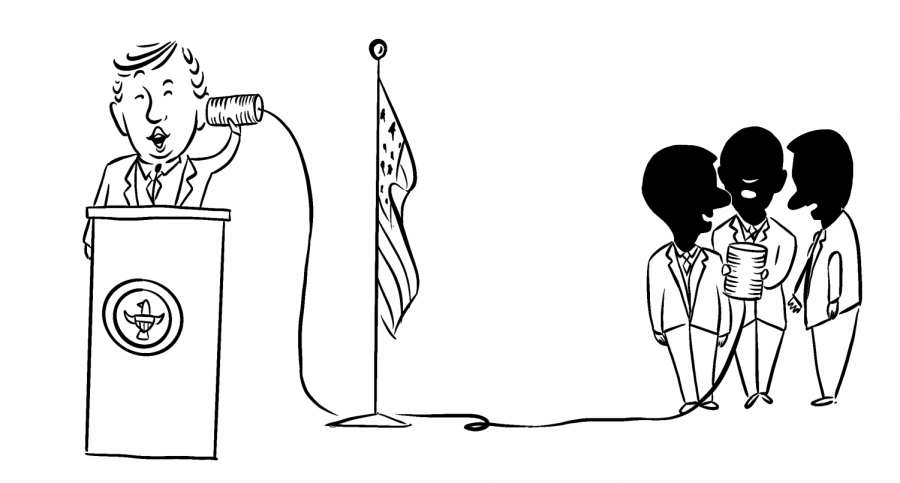No, Trump is not to Blame for the Effects of the Pandemic on America
While Mishaps Have Caused Backlash, the President is Undeserving of the Criticism to His Response
May 28, 2020
The coronavirus pandemic has had an unprecedented effect on American society. At the time of writing this article, nearly 90,000 US citizens have died from the virus and over a million have been infected. The United States has found itself unprepared for this pandemic, and our lackluster response has been clearly illustrated in the nation’s shortage of masks, drugs, and ventilators. Many people are understandably angry that the US did not take more effective steps to curtail the impacts of this pandemic, and most of the blame was put on President Trump. Despite this anger, and even despite some critical and continued missteps in his response, Trump has acted reasonably overall. The true culprit in this scenario is not an uninformed and error-prone president, but a woeful lack of preparation at the national level that stems back decades.
The true culprit in this scenario is not an uninformed and error-prone president, but a woeful lack of preparation at the national level that stems back decades.
Even though Trump isn’t to blame for putting the US in the situation it is in now, it is clear that his actions in office have undermined the effectiveness of our response to the virus. First, Trump’s initial effort to downplay the virulence of the coronavirus, perhaps to assuage public fears and maintain forward momentum in the stock market, was dangerous and made people less afraid than perhaps they should have been about the threat of the coronavirus. Additionally, Trump seems compelled to comment about medical issues far beyond his field of expertise—such as the benefit of hydroxychloroquine as a treatment for COVID-19 and his suggestion that disinfections could be used as a medicine—undermine Trump’s position of authority. He should instead rely on his experts to make medical judgments and stick to commenting about politics. Trump has also made comments to undermine his efforts to enforce protective measures. For example, he sent tweets encouraging anti-social-distancing protestors in Michigan and he called out democratic states like Illinois as being unworthy of federal aid. These actions are counterproductive and prevent Americans from working together to solve this crisis as quickly as possible.
Many of Trump’s detractors argue that Trump had been made aware about the potential for the coronavirus to spread globally long before he took action. However, while it is true that Trump was briefed in January about the threat, no one could have predicted the extent to which the virus would spiral out of control. This is especially true because China has not been transparent since the beginning of the outbreak about the severity of the virus, the number of people infected, or the Chinese government’s lack of control on the situation. Perhaps if Trump knew how dire the situation in Wuhan was, he might have acted faster. Despite this, Trump did ultimately take radical action. The US became one of the first countries to ban travel to China, which was a drastic step considering how important trade relations between the US and China have become to both countries’ economies. Even though in retrospect, it might seem like Trump should have done more sooner, Trump couldn’t have known the devastation that the virus was going to cause and so taking extreme action at the time would have seemed like an overreaction.
Trump’s critics also argue that he hasn’t done enough to secure funds and medical supplies to help stop the pandemic. Many people now blame Trump’s decision in 2018 to disband the National Security Council’s pandemic-response office as a factor in the US’s disorganized response to the pandemic. They claim that the resulting shortages of ventilators and hospital beds nationwide is due to a lack of a team dedicated to organizing a response. However, Trump’s decision merely reflects a history of neglect for the US healthcare system. For example, in 2015, New York’s Governor, Andrew Cuomo, was given a report by the New York State Department of Health which explicitly stated that, in the event of a epidemic like the Spanish Flu in 1918, New York’s existing stockpile of ventilators would not be able to handle the overwhelming influx of patients into hospitals. Cuomo, like many other governors, decided that such a pandemic was unlikely and chose not to invest in augmenting his supply of ventilators. Similarly, Dr. Gus Birkhead, the top official at the New York State Department of Health until 2015, explained that the National Stockpile had only 16,600 ventilators, which does not nearly approach the 750,000 that experts are now calling for. No one anticipated a repeat of the 1918 epidemic, so no one in federal, state or local governments decided to prepare for such an unlikely event, even though scientists warned that doing so left the country exposed to a grave threat.
Trump has clearly made mistakes in America’s response to the coronavirus pandemic. He downplayed the severity of the virus initially (despite warnings from his advisors), and federal relief measures such as medical supplies and financial aid have been incomplete at best. However, to blame the US’s current problems entirely on Trump’s response is not looking at the broader picture. The United States was simply not prepared to handle a large scale pandemic like COVID-19, and we haven’t been for years. This kind of natural disaster simply wasn’t a priority for federal and state governments because it seemed like a waste of money preparing for an event that may never happen. Moreover, taking radical steps to close the country seemed completely unimaginable to us in January, so Trump’s ineffective attempts to rally medical supplies and funds for states during the early weeks of the pandemic was a direct result of the failings of America’s previous leaders to setup an effective contingency plan for a pandemic.










